The secret to good health is optimal sleep… and for peaceful sleep, you need a quality pillow to wash away your fatigue.
But, due to the varying size, filling, firmness level, and even your sleeping position, you can’t mindlessly buy ANY pillow. To get that dreamy good night’s sleep, you need a pillow that caters to your specific needs.
Wondering how to choose a pillow? Let this guide help you out…
Types of Pillows
If you’re a new pillow buyer, know that pillow filling or material is the most confusing part.
But the fun part is that you can choose your pillow based on your necessities… and not worry about “how to sleep on a pillow” to adjust your body with it.
NOTE
We have enlisted our recommended pillows in this guide, here.
So, let’s explore all the available types with added benefits of sleeping with a pillow…
1. Down Pillow
The filling of these pillows is made of goose, duck, or swan down (the soft fibers near the birds’ skin, not the feathers). Sometimes, manufacturers might blend feathers into the down, so always check for the down-to-feather ratio before buying,
Down is an animal product, so make sure your down pillow is ethically sourced with the Responsible Down Standard (RDS) certification.
Benefits
- Since down is mouldable, soft, and cushiony, it gives great neck and head support.
- High durability, lightweight
- It has great insulation so feels warm in winters
Drawbacks
- Due to the insulation, it overheats during warmer weather
- You might get allergic reactions
- The pillow might lose loft without fluffing
- Difficult to clean
- You must search well for RDS certification
Suitable for
This is the best pillow for all sleeping positions – side, back, and stomach – due to the soft cushiony feeling.
2. Down Alternative Pillow
This is the vegan version of down pillows. It usually contains synthetic fibers like polyester. Polyester mimics the softness of down.
Benefits
- Affordable
- Hypoallergenic
- Easily cleanable
- No issue with ethical sourcing
Drawbacks
- May become lumpy overtime
- Not as insulating as down
- Not as moldable as down
Suitable for
This is the best pillow for sleeping on the back and side. Stomach sleepers may try it, but it isn’t completely comfortable for them.
3. Feather Pillow
It contains traditional feather filling which is supportive and comfortable. But the feathers might contain slight leftover down and cause allergic reactions. So, notice the constituents before purchasing.
Benefits
- Affordable
- Lightweight
- Doesn’t lose shape
- Moldable
Drawbacks
- Might lose loft without fluffing
- Difficult cleaning process
- Retains body heat and overheats
Suitable for
Best pillow for back sleeping and side sleeping as they have a higher loft than down and are as soft and fluffy as down.
4. Cotton Pillow
Though this kind is losing popularity, classic cotton is great if you’re allergic to synthetic filling. You can even wash them regularly.
Benefits
- Breathable and light
- Hypoallergenic
- Odorless
Drawbacks
- Regular cleaning necessary to avoid mold and mite infestation
- Won’t contour to head
- Becomes lumpy over time
Suitable for
Great for all sleeping positions but won’t mold your head, so choose wisely.
5. Latex Pillow
It provides great support to both your neck and head and leaves a cozy and soft feeling. They’re available in both solid and shredded materials. But avoid latex blends especially the polyurethane foam ones as they’re toxic.
Benefits
- High durability
- Breathable and cooling sensation
- Moldable
- Biodegradable
Drawbacks
- Might cause allergic reactions
- Expensive
- Has an odor
Suitable for
Best pillow for side sleeper and back sleeper only. The higher loft is unsuitable for stomach sleepers.
6. Memory Foam Pillow
This type of pillow can mold and contour any shape of your body, so it fits your head and neck perfectly.
Benefits
- Contours your body shape
- Doesn’t clump
- Helps in pain relief
Drawbacks
- Must choose foam density that won’t impact breathability
- May overheat
Suitable for
Usually great for all sleeping positions, but might be too stiff for side sleepers.
7. Shredded Memory Foam Pillow
A popular alternative to the traditional memory foam option as you can adjust the foam filling as per your preference.
Benefits
- Non-clumping
- Moldable
- Customizable filling
- Easily cleanable
Drawbacks
- Chemical off-gassing
- Might feel overstuffed and stiff initially
- Wears out with time
Suitable for
Best pillow for back and side sleepers. Some stomach sleepers like it, while others feel uncomfortable from the firmness.
8. Bamboo Pillow
These pillows usually contain shredded foam filling with a shell of bamboo viscose. This allows you the cooling from bamboo along with all benefits of shredded memory foam pillows.
Benefits
- Antimicrobial
- Moisture-absorbing
- Hypoallergenic
- Cooling properties
Drawbacks
- Chemical off-gassing
- Heavy pillow
- Difficult cleaning
Suitable for
Best pillow for back sleeping only as it’s too firm for stomach and side sleepers.
9. Gel Pillow
These are made of a combination of gel and other materials latex and foam. This combination provides the cooling properties of gel along with the other material’s softness.
Benefits
- Holds shape well
- Moldable like memory foam
- Hypoallergenic
- Cooling properties
- Easy to care
Drawbacks
- Might feel too firm for some
- Expensive
Suitable for
It’s great for only stomach and back sleeping positions but too firm for side sleepers.
10. Polyester Pillow
Aka polyester fiberfill or poly-fill is popular for its low cost. But the quality is far lower and you might need to replace them as they don’t last long.
Benefits
- Hypoallergenic
- Lightweight
- Affordable
Drawbacks
- Non-breathable
- Overheating issues
- Forms lump too fast
- Not long-lasting, so it isn’t cost-efficient
Suitable for
This type of pillow is available in a range of firmness, so it’s the best for all sleeping positions.
11. Buckwheat Pillow
This was popular in Asia and slowly gained status in North America. Its filling contains buckwheat shells which are both firm and breathable.
Benefits
- Flexible
- Breathable
- Cooling
- High durability
Drawbacks
- The shells are noisy when you move around in sleep
- Heavyweight
- Might feel too firm for some
Suitable for
This is good only for back and stomach sleepers. It’s too firm and noisy for side sleepers.
12. Microbead Pillow
The sensation of these pillows is similar to buckwheat ones. However, these contain a synthetic filling called uniform polymer particles and these can’t hold their shape as long as buckwheat ones.
Benefits
- Breathable
- Moldable
- Good firmness and supportive
Drawbacks
- Chemical off-gassing
- Overheating issues due to poor heat conductivity
- Isn’t durable enough like buckwheat ones
Suitable for
One of the best pillows for back sleepers due to its high firmness. But some stomach sleepers might also like it.
13. Water-filled Pillow
These types have removable bags to fill water in. You can adjust the water level for your preferred firmness. The outer shell is usually cotton or polyester.
Benefits
- Moldable and supportive for all body parts and sleeping position
- Pillow doesn’t shift away due to its weight and supports you overnight
- Affordable
- Easy to care
- Durable
Drawbacks
- Might leak depending on manufacturing faults or poor maintenance and handling
Suitable for
Since the water level is adjustable, it’s suitable for all types of sleepers
14. Kapok Pillow
These are made from the organic fiber of tropical Kapok trees. The material is silky and much lighter and softer than down. So, many refer to it as a vegan down alternative.
Benefits
- The texture and sensation on the skin mimic down pillows
- Vegan
- Moisture wicking
- Eco-conscious because trees aren’t chopped for the fibers. They harvest the filling from fallen seed pods from the tree.
- Customizable variants might be available
Drawbacks
- Chemical off-gassing if you use a blended option
- Extremely flammable, so a bad choice if you have a fire near your bedside
- Sometimes, adjusting the fill might not help
Suitable for
Best pillow for side sleepers and hot sleepers. It might work for back sleepers. Not a great choice for stomach sleepers as it’s too firm.
But the material alone doesn’t rule your comfort level, so let’s check the other parts too…
What to consider before buying a pillow?
Often when you research pillows online, you might get article suggestions like “Is it bad to sleep without a pillow?”, find the different benefits of sleeping without one with the drawbacks of sleeping with one… and hesitate to find your dream pillow.
Well, the perfect pillow won’t disappoint you with any issues. Curious which is perfect for you? C’mon, let me take you on a ride…
1. Size
Though the varying pillow sizes can be confusing, any average sleeper can work with the standard size. But if you move a lot in your sleep, pick one size up. The sizes available are:
Standard: 20 × 26 inches
Queen: 20 × 30 inches
King: 20 × 36 inches
The perfect pillow size also depends on your bed size. Try to choose a proportional pillow size for your bed.
For instance, a standard pillow looks mismatching with a king-size bed as it’s too small, so go up by one size. Similarly, the standard size might seem too big for a smaller bed.
2. Firmness and filling
The firmness of your pillow depends on your sleeping position and the type of support your head and neck need. You need a pillow that will put your head at a comfortable level with your spine, neither too far up nor too far down. So, your neck mustn’t be bent.
Side sleepers: Choose a soft to a medium firm pillow with a high loft. This will protect your neck from any strains.
Back sleepers: You need a medium-firm pillow but it mustn’t push your head too far ahead. Make sure. A flatter pillow might help you better level your head.
Stomach sleepers: Pick pillows that don’t make you crane your neck on the bed. Medium to medium-firm with less loft will give you the perfect angle to relieve stress at the neck.
Fidgety sleepers: If you move in your sleep between back and side positions, choose the specified firmness for the position you usually fall asleep.
3. Heating issues
Depending on the amount of heat your body releases, the quality of your sleep varies.
If you’re a hot sleeper: You might sweat a lot and it’ll interrupt your sleep at night repeatedly if you sweat. You need breathable pillow coverings and fillings. Cooling materials like gel, latex, shredded foam, and polyester can be an added benefit for you.
Avoid memory foam as they retain your body heat and heats you up. Never choose a “cool gel layer” option as they initially feel cool and later heat up.
If you’re a cool sleeper: Any material works for you but memory foam will work better for winter nights to keep you warmer.
4. Allergy issues
You might have an allergy to the most random materials. So, it’s better to get yourself tested before choosing the materials. Some might be allergic to buckwheat and/or latex and these are easily available in the market
If you’re allergic to bird allergens like feather dust and mites, pick polyester, cotton, down alternative, or gel options.
Or, if you want feather or down pillows, make sure they’re cleaned properly in the manufacturing process and you also regularly clean them.
Some dust mites particularly infest synthetic materials, so knowing your allergens can really help. Even the “hypoallergenic” label doesn’t guarantee you won’t be allergic to it.
Only synthetic latex doesn’t have high allergic reaction reports but it might emit formaldehyde and have dust mites. If you’re particularly allergic to dust mites but not the pillow filling or covering, invest in a pillow protector.
5. Mattress type
Depending on the firmness of your mattress, your body sinks to different degrees. So, your pillow thickness must complement your mattress quality to evenly support your spine throughout. For instance, for a:
Firm mattress: Stick to a fuller pillow because your body won’t sink much in a firm mattress. A thick pillow will fill the large gap between your head and mattress.
Soft mattress: Look for a thinner pillow because your body digs in deeper in a soft mattress. This leaves very less gap between your head and mattress. A thin pillow will fit the gap perfectly.
6. Adjustable features
If your comfort needs vary with different factors, you might soon get dissatisfied with your pillow and look for a new one. If this story sounds familiar, pick a customizable filling pillow.
You can remove or add the volume of filling to suit your preferences. Usually, these pillows come with a manual to adjust your pillow based on your sleeping position.
Worried about the pocket pinch? Let’s get rid of the worries here…
How much does an average pillow cost?
Prices of pillows range from $10 to $1000 but a majority are available for $300. Depending on varying materials the price ranges are as follows:
- Down: $15 to $250
- Feather: $25 to $50
- Down Alternative: $20 to $30
- Memory Foam: $50 to $150
- Latex: $100 to $150
- Polyester: $10 to $80
- Gel: $40 to $50
- Cotton: $50 to $100
If you want added discounts, visit the department stores on Black Friday. You might also get a “White Sale” in January right after New Year’s.
Can’t decide between online and offline shopping? Let’s help you with little details…
Where to buy a pillow?
In this age of online shopping, it’s hard to imagine visiting a traditional store to pick your bedding. The convenience of online shopping is always attractive. But when it comes to such intimate essentials as pillows, consider the options well…
1. In-store Purchase
If you go to a brick-and-mortar store, place the pillow and compress it with your palm for a quick squeeze test. This can help you check the required firmness for your sleeping position.
If there are shredded or multiple filling pieces instead of a single solid one, fluff it to check if it can return its initial form.
Ask the shopping assistant to let you lie on it and check the breathability especially if you’re a hot sleeper. Check the cover for straight seams, neat stitches, and secure piping and zippers.
2. Online Purchase
In online pillow purchases, you can scroll through for hours and compare the specifications. Seek the best fit for yourself with the help of our guide.
Since you can’t check the product yourself, choose products with at least 30-day return policies. Skip to different retailers if there’s a hidden return fee or if the product isn’t refundable.
Confused between all the varieties? Let’s help you out with a few suggestions…
What pillow should you Buy? – Our Top 5 Recommendations
Bedding purchases can be confusing because of the vast teeth-breaking descriptive language about the products. But, you can easily find your perfect pick if you focus on the important details.
So, what might they be? Let’s walk you through our best picks along with the only details you need to know (and don’t worry, you don’t have to buy these to be our favorite!)…
1. Yana 360° Body Pillow
This 55” × 28.5” pillow wraps you all around and supports your body all around and beats most competitors in the market.
Why it is on our list?
- Available fill type: Natural Latex and Latex-free Natural Cooling Gel
- Customizable fullness
- OEK-TEX standard 100 Certified [harmful chemical-free]
- Available with a pillow cover
- 4 interest-free EMI payments available
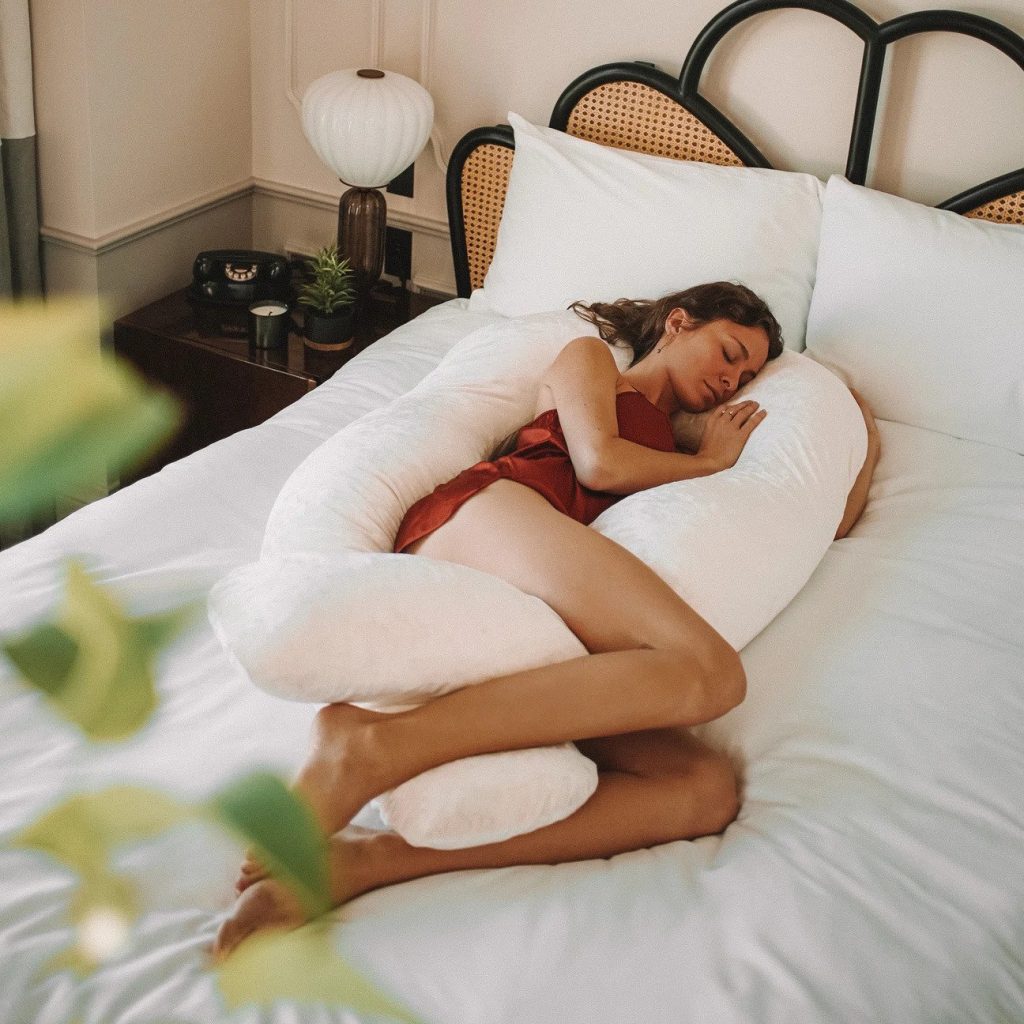
2. Flip Pillow
This versatile bed and lounge pillow supports multiple (almost 10) sleeping and even sitting positions.
Why it is on our list?
- Available sizes: standard [29” × 20” × 8”] and the king [29” × 30” × 8”]; Available colors: White, Beige, and Navy Blue
- Non-saggy
- Machine washable and dryer fluffing possible
- Soft hypoallergenic fiberfill
- 45-day returnable and fee waived policy
- 1-year Contour Customer Care warranty
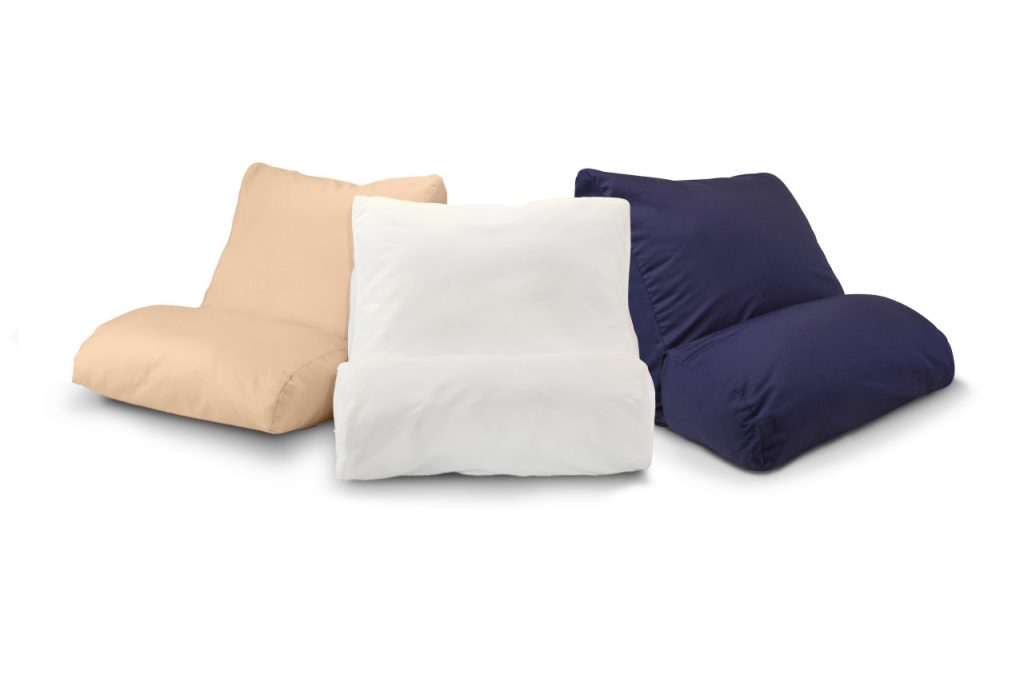
3. Nolah Squishy Pillow
You can customize the firmness and feel of this 2-pack pillow set. It is available in Queen size [18” × 24”] only and has a bamboo blended cover and contains shredded foam filling.
Why it is on our list?
- Supportive and squishy
- Responsive cushioning on the exterior
- Cooling fill with high airflow
- Breathable bamboo pillow cover
- Soft bamboo fibers
- Naturally antibacterial
- Wicks moisture
- OEKO-TEX Standard 100
- 120-night free trial
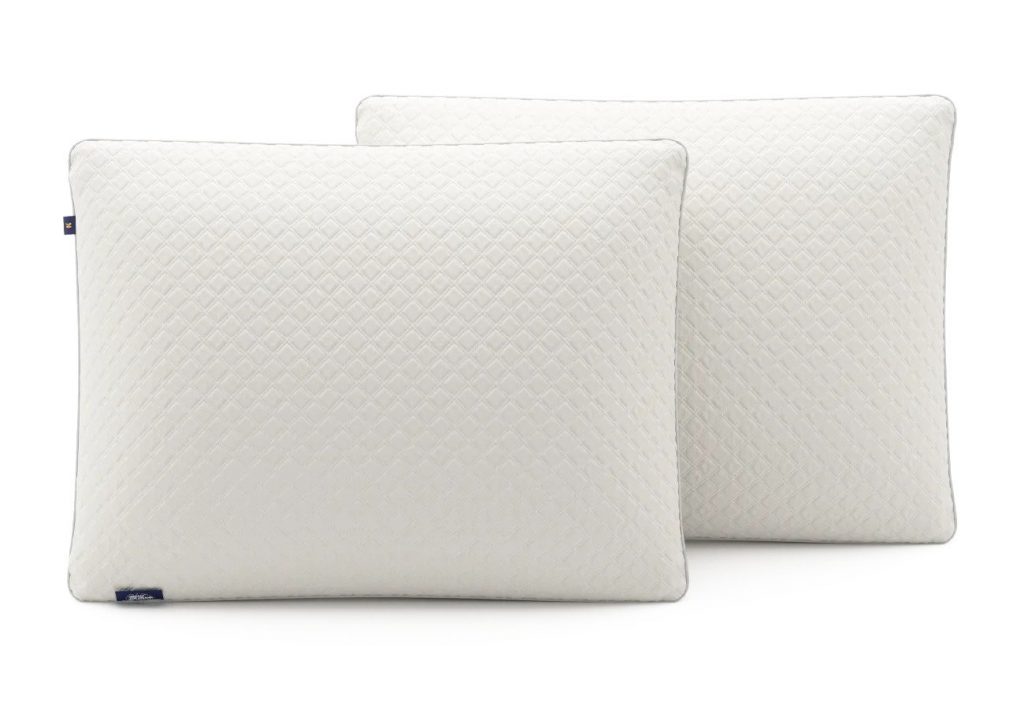
4. LAYR Customizable Pillow
This pillow is available in king and queen sizes and single pieces and pairs. They also guide you to find your perfect filling on their website with insert adding and removals.
Why it is on our list?
- Both height and firmness are adjustable
- Gel-infused memory foam with CertiPUR-US certification
- Advanced cooling technology
- Machine washable pillow and insert covers
- OEKO-TEX standard 100 certified
- 30-day return policy with the added return shipping charge, pillow price refundable.
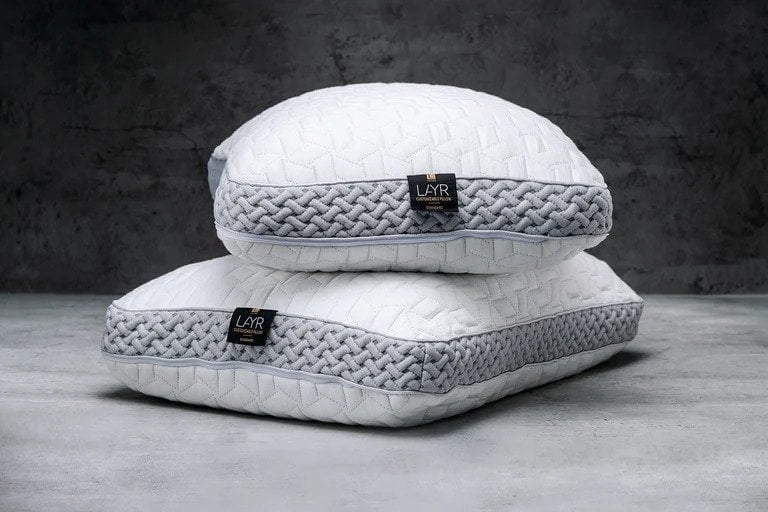
5. Moonbow: The Adjustable Plush Memory Pillow
This five-layer adjustable pillow contains quality memory foam. It’s suitable for all sleeping positions and instantly reshapes when you move your head. It comes with a Bamboo-polyester blend pillow cover.
Why it is on our list?
- Soft and cooling pillow cover
- The pillow cover zipper secures the layers well
- 1-year warranty
- Free US shipping, Worldwide shipping rate: $10
- 100-night trial period, no return charges
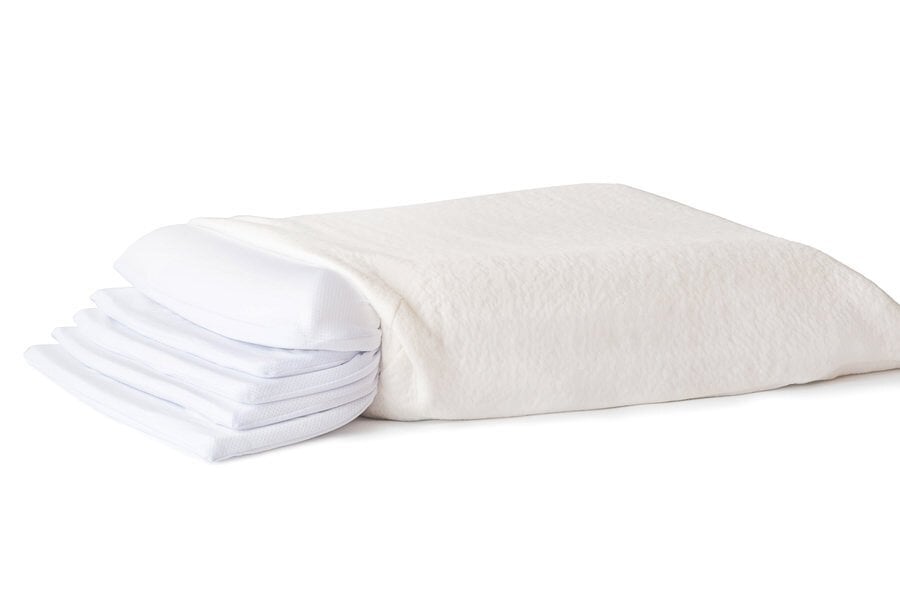
If you feel attached to your pillow and don’t want it to split apart, you’re not the only one. But, for your own health, let’s know when to say adieu…
When should you replace your pillow?
If the quality of your sleep declines, i.e., you wake up with neck pain or sneeze after going to bed, it might be time to replace your pillow. Since bacteria and dust mites infest pillows much sooner, get a hypoallergenic one.
Other possible signs to replace a pillow are stains, discoloration, bad odor, and lost shape. Even if you don’t see physical signs, replace your pillows every 2 years to sleep on a comfortable, clean, and allergen-free pillow.
Final Statement
Since, choosing a pillow is no child’s play, be prepared to research in-depth with ample time on your hand. If you’re in a hurry to get a new pillow, that might mislead you to the wrong one.
Moreover, despite your purchase mode (online or offline), it’s better to check in person what you’ll get. So, if you figure out all the specifications, skim through multiple stores and compare their products.
In fact, don’t shy away from asking your shopping executive’s personal favorite. Leave no page unturned to find your dream pillow because your sleep is precious.

